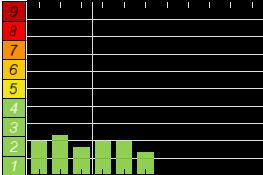Прогноз прохождения радиоволн
| Если вы тут впервые, то посетите наш раздел для начинающих - введение к прохождению радиоволн на КВ |
- Прогноз солнечной активности российской лаборатории "ИЗМИРАН"
- Программное обеспечение для расчетов прохождения на своем компьютере
- Ссылки на всемирные источники прохождения радиоволн
Рекомендованные статьи о солнечной активности:
- Ионосфера и ее изучение
- О сверхдальнем распространении на КВ
- Прогноз рабочих частот делаем самостоятельно
- Прогноз тропосферного прохождения
- Сверхдальние QSO: оптимальные направления и периоды
- Прохождение на КВ диапазонах
- Снова сверхдальняя радиосвязь
- Как сделать прогноз прохождения
- Стоит ли повышать мощность?
- СНЭРА: прогнозирование радиоавроры
- О дальнем и сверхдальнем распространении
коротких волн
- Эхо магнитных бурь
- Опасаться или не обращать внимания
- Явления влияющие на прохождение радиоволн
Текущее состояние ионосферы:
|
||||||||||||||||
|
Прогноз авроры в северном полушарии 
|
|
Прогноз УКВ 
|
Прогноз сервера SIDC.BE: (Правила перевода)
Опубликовано: 10 декабря 2025 в 1249 UTC
SIDC URSIGRAM 51210
Состояние солнечной активности на 10 декабря 2025, 1248UT
Прогноз SIDC
Солнечные вспышки. Ожидаются вспышки класса M (вероятность >=50%)
Геомагнитное поле: Возмущенное (A>=20, K=4)
Солнечные протоны: Ожидается увеличение возмущенности (уровни активности повысятся,
но точного числового прогноза нет)
Прогноз на 10 декабря 2025: Солнечный поток в диапазоне 10см: 181 / AP-индекс: 012
Прогноз на 11 декабря 2025: Солнечный поток в диапазоне 10см: 178 / AP-индекс: 022
Прогноз на 12 декабря 2025: Солнечный поток в диапазоне 10см: 176 / AP-индекс: 012
Комментарий (на английском языке): Solar Active Regions and flaring: Solar flaring activity was moderate over the past 24 hours, with four M-class flares. The strongest flare was an M1.9 flare (SIDC Flare 6377) peaking at 07:37 UTC on December 10, which was associated with SIDC Sunspot Group 709 (NOAA Active Region 4294, magnetic type beta-gamma-delta). There are currently seven numbered active regions on the solar disk. The most complex one is SIDC Sunspot Group 709 (NOAA Active Region 4294). SIDC Sunspot Group 719 and SIDC Sunspot Group 714 (NOAA Active Region 4300) have decayed into plage regions. SIDC Sunspot Group 713 (NOAA Active Region 4298) is currently rotating across the west limb. The solar flaring activity is expected to be moderate over the next 24 hours, with M-class flares very likely and a small chance for X-class flares. Coronal mass ejections: No Earth-directed Coronal Mass Ejections (CMEs) were observed in the available coronagraph imagery in the last 24 hours. Coronal holes: A northern, north-south elongated, negative polarity coronal hole (returning SIDC Coronal Hole 142) is crossing the central meridian. An associated high-speed stream may arrive at Earth starting from December 13. Solar wind: Over the past 24 hours, the solar wind parameters (ACE) reflected mostly slow solar wind conditions. A small increase was observed in the solar wind parameters around 03:00 UTC on December 10, possibly due to an ongoing, weak influence of an ICME arrival. Speed values increased from 370 km/s to 430 km/s. The interplanetary magnetic field values increased from 7 nT to 13 nT. The Bz component reached a minimum of -8 nT. The interplanetary magnetic field (IMF) angle was in the negative sector until around 05:00 UTC on December 10, when it shifted to the positive sector. Enhanced solar wind conditions may be expected over the next 24 hours, due to the small chance of arrival of a glancing blow associated with the Coronal Mass Ejection (SIDC CME 607, observed around 22:36 UTC on December 08). Geomagnetism: Geomagnetic conditions globally and locally were mostly at quiet levels (NOAA Kp 1 to 3, K BEL 1 to 3). Quiet to active conditions (NOAA Kp 1 to 4), with a small chance of minor storm conditions, are expected over the next 24 hours due to the small chance of arrival of a glancing blow associated with the Coronal Mass Ejection (SIDC CME 607, observed around 22:36 UTC on December 08). Proton flux levels: The greater than 10 MeV proton flux was below the 10 pfu threshold level over the past 24 hours. It is expected to remain below the threshold level over the next 24 hours, pending no further eruptive activity from SIDC Sunspot Groups 709, 712 (NOAA Active Regions 4294, 4296). Electron fluxes at GEO: The greater than 2 MeV electron flux measured by GOES 18 and GOES 19 was close to the 1000 pfu threshold but remained mostly below it in the last 24 hours. The greater than 2 MeV electron flux is expected to remain below the 1000 pfu threshold levels in the next 24 hours. The 24-hour electron fluence is presently at normal levels and is expected to remain so over the next 24 hours.Сегодняшнее значение числа солнечных пятен (International Sunspot Number): 133,
получено на основе анализа результатов 10 станций наблюдения.
Солнечные индексы за 09 Dec 2025
Число Вольфа по данным обсерватории Катания (IT9): 182
Солнечный поток в диапазоне 10см: 183
A-индекс по данным обсерватории Chambon-la-Foret (F): 010
A-индекс по данным обсерватории Wingst (DL): 004
Планетарный А-индекс Ap: 003
Вчерашнее значение числа солнечных пятен (International Sunspot Number): 154,
получено на основе анализа результатов 13 станций наблюдения.
Прошедшие события на Солнце:
DAY BEGIN MAX END LOC XRAY OP 10CM Catania/NOAA RADIO_BURST_TYPES
09 1500 1514 1520 S13W51 M1.5 1 21/4294
09 2313 2327 2336 S17W44 M1.5 SF 23/4296
10 0417 0422 0427 S14W60 M1.2 SF 21/4294 III/2
10 0731 0737 0742 S15W62 M1.9 1N 21/4294
(Прогноз бельгийского сервера SIDC - Правила перевода)
|
SAF = Прогноз солнечной активности. Показания индекса К снимаются с интервалом
в три часа. Они показывают текущий уровень активности магнитного
поля Земли (в данном случае записаны в городе Boulder, штат Colorado).
Обратите внимание, что это данные могут не соответствовать той географической
зоне, в которой вы находитесь, однако являются в определенной степени
усредненными. |
Состояние магнитного поля:
(Прогноз российской лаборатории "ИЗМИРАН")
(Прогноз российской лаборатории "ИЗМИРАН")

